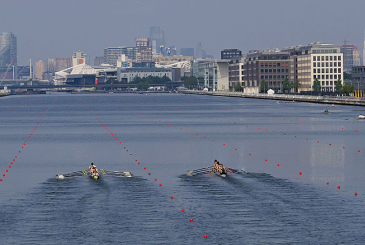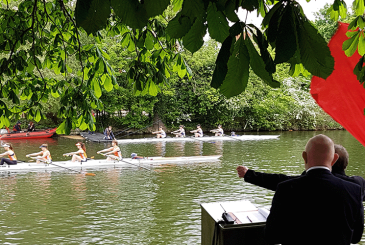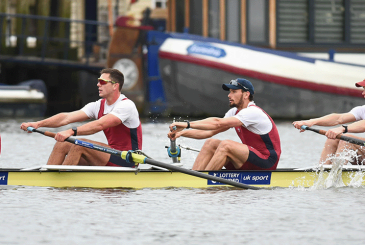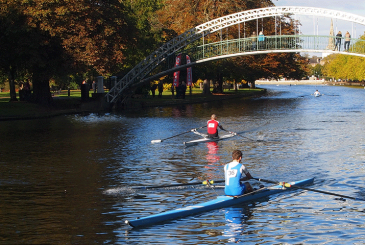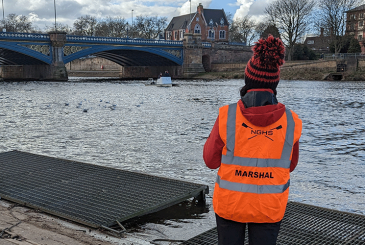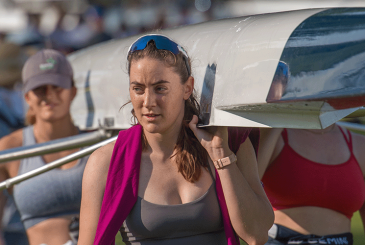BBC weather presenter and cox Jen Bartram provides advice on how to prepare for bad weather
Winter training brings out a rower’s hardy streak. With steely determination, unmatched in many other sports, we brave rain, wind, snow and even ice to get the outings under our belts during the winter season. Bad weather in training is generally regarded as an inconvenience. But for race organisers, it can mean months of planning going down the pan, as well as leading to financial losses and having to deal with hundreds of disappointed rowers.
Head racing is particularly vulnerable to stormy weather because of its seasonal nature. During the winter months, the jet stream – a ribbon of fast-moving air, high up in the atmosphere – is much stronger than in summer, which can intensify low pressure systems, steering strong winds and heavy rain towards the UK.
Such weather poses a significant risk when racing. Strong winds can quickly cause swamping or push boats onto moorings – and multiple capsizes in cold water is the nightmare scenario for event organisers. Having too many people to rescue without the safety assets to help them all quickly can prove fatal.
Dave Tarvin has run a private safety boat for over 15 years on the Tideway and has seen the impact of bad weather at first hand.
“We’ve had it all: wind, hail, lightning, snow, fog – even being too hot. Wind can be a problem in an eight, through overlapping waves or steering. One crew got caught by the stream and snapped the boat in 20ft of tidal water!
The jet stream can intensify low pressure systems, steering strong winds and heavy rain towards the UK
“We’ve also had a lot of crews in the winter heads – particularly juniors – not dressing up warmly enough. There can be a lot of waiting on the water pre-racing and it doesn’t take a lot for body temperatures to drop dangerously, especially if it’s raining too. Most rowers don’t have a lot of body-fat padding!”
Assessing the risk
Severe weather is having a significant impact on the racing calendar. During the first six months of 2019, there were no fewer than 30 race cancellations around the UK due to bad weather, including the BUCS Fours and Eights Head in Gloucester and the Women’s Eights Head (WEHoRR) on the Thames.
The uncertainty in weather forecasting can mean that organisers come under pressure to wait until the last minute to cancel – but an early decision allows people to amend plans and avoids abandoning a race with crews and marshals already afloat. A robust risk assessment matrix that incorporates bad weather can help organisers to reach that decision objectively.
We’ve had it all: wind, hail, lightning, snow, fog – even being too hot
In March 2019, the WEHoRR race committee had a dedicated weather team assessing forecast models twice a day in the week leading up to the race. When it became clear that wet and windy weather would threaten the event, the committee put a pre-planned communications strategy into action to ensure that competitors, spectators and volunteers could be informed as early as possible.
“I never felt any pressure to run the race,” says Guin Batten, WEHoRR race coordinator.
“The pressure was to make a really good, non-emotional decision that would protect everybody. As a committee, we hate the prospect of cancellation – so much time is put in through the year that we were as devastated as the rowers, if not more so!”
The decision to cancel in good time earned the organisers a lot of support on social media – though there were still some people insisting the event should proceed. They were wrong: conditions on the day were so choppy it would have been impossible to run the event safely.
“The vast majority of people were really supportive of the tricky situation and told us they’d definitely be back next year,” adds Batten.
Organisers need to consider every aspect involved in getting crews onto the water. Boating and marshalling can be much harder when the wind is strong, and crews sitting for a long time in wet and windy weather can risk hypothermia.
As a committee, we hate the prospect of cancellation – we were as devastated as the rowers, if not more so!
Safety on land is just as important: towing a trailer in strong winds can be tricky, even for experienced drivers. Gusty winds can blow unsecured boats off during loading and unloading, and structures such as tents and gazebos have been known to blow into the river!
Knowing the local conditions
Checking the weather forecast is only half the battle. Knowledge of local conditions can prove crucial when it comes to assessing the safety of a course.
Heavy rain in a short space of time can cause rivers to rise rapidly.
Changing environmental factors, such as lack of tree cover and drainage of moorland, can mean that run-off into rivers becomes more rapid, as well as causing flooding.
Visitors to Durham in June 2019 may have been surprised to see that the historic two-day regatta had been cancelled: the weekend was forecast to be warm and sunny. But upstream, heavy rainfall the previous night had caused the River Wear to rise significantly, and organisers knew this would reach the venue several hours later.
“By the time officials got to Durham Rowing Club, the river was already unsafe for rowing – not just the speed of flow, but also with large trees and other debris,” explains Nigel van Zwanenberg, regatta chairman. “Knowing what was still to come from further up the valley meant there was no choice but to cancel immediately.
“Before 2019, there had been one full cancellation in over 180 years. Now it is twice in 180 years, but more relevantly twice in seven years, so the weather and river conditions may well be changing.”
It can be flat-calm at the landing and howling a gale at the tarn end
Lack of rainfall can also be a problem. The River Wear, like many others, is beginning to silt up; dry spells of weather can cause the channel to become narrower, making it difficult to move boats back to the start during races.
Talkin Tarn ARC’s home is a small glacial lake in Cumbria, which has a microclimate of its own. In winter, it’s been known to freeze over completely, halting rowing for almost two months! It’s also home to the UK’s only named wind – the Helm Wind – which can be fiercely strong.
Hannah Rigby from Talkin Tarn says local weather knowledge is essential.
“It can be flat-calm at the landing and howling a gale at the tarn end [the regatta start-line], so understanding the water and its volatility, alongside your own ability in a boat, is important,” she says.
“Luckily, as we’re a lake and not a river, you’re never far from the landing if the weather takes a turn for the worse.”
Recouping the costs
Cancelling events due to bad weather can have a severe financial impact. Although set-up costs can be modest, loss of income can be a real concern for clubs of all sizes,many of whom rely on an annual event to bolster their finances.
Establishing and publishing a refund policy can go some way to helping clubs deal with unrecoverable costs. Cancellation insurance can be an expensive option but may well become a necessity for larger events that cannot risk the financial loss.
The future
Severe weather is undoubtedly having an impact on rowing in the UK. Race cancellations are more likely now than in the past, due to improved health and safety and risk assessments – and, partly, the worry of litigation. As our planet warms and the extremes of weather that threaten our sport become more common, it may be that the traditional racing calendar will look rather different in years to come.
5 top tips for preparing for bad weather
Tip 1: Check the forecast
Most weather providers can give you a forecast around a fortnight ahead, with several offering monthly ‘trend’ forecasts to give you a hint of what weather you might be able to expect. Plan early!
Tip 2: Lightning? Remember the 30:30 rule
In the case of a thunderstorm, the 30:30 rule can help. If the gap between flash and bang is 30 seconds or less, you should seek shelter. Staying inside this shelter is advised until 30 minutes after the last clap of thunder.
Tip 3: Keep an eye on river gauges
Particularly useful after heavy rain, gauge levels are available online for all rivers in the UK. As well as checking for your own location, looking at what’s happening in the wider catchment area can give you an idea of conditions to come.
If the gap between flash and bang is 30 seconds or less, you should seek shelter
Tip 4: Have your kitbag well stocked
If you are going out in cold weather, layers are your friend. In warmer weather, sunscreen and protective headgear are a must – but also think about taking sufficient hydration and extra nutrition, especially when racing.
Tip 5: Use the time for land training
We know it’s not the same, especially in summer, but if the weather’s that bad, jump on the erg and get a session in – the sun will be back out soon enough and you’ll be back on the water fitter and more enthusiastic!
Jen Bartram is a BBC presenter and producer who has spent the last decade working in weather forecasting and often provides bespoke rowing forecasts on social media. When not at work, she can usually be found using her microphone technique in the cox’s seat at Parr’s Priory RC. Follow Jen on Twitter @JenBartram



